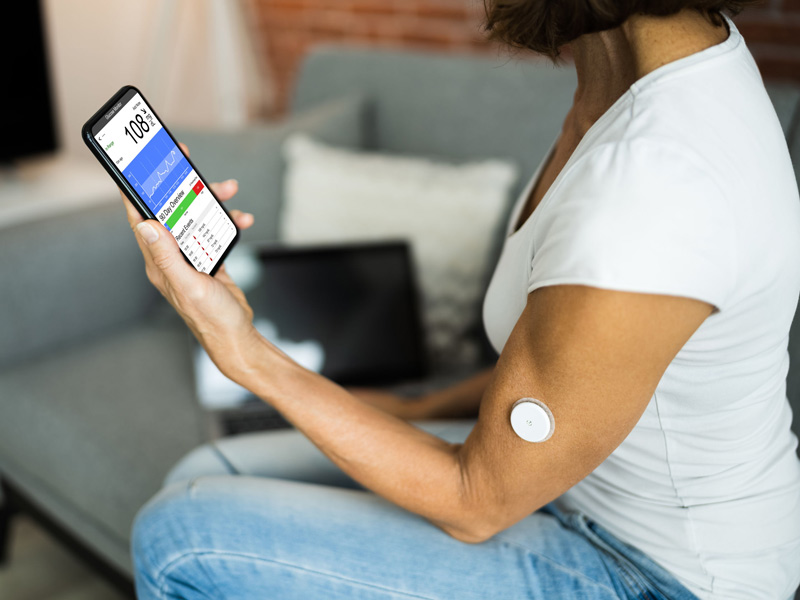New AAFP TIPS Topic Covers Continuous Glucose Monitoring
Resource Is Part of Academy’s CGM Series
April 22, 2021, 6:14 p.m. News Staff — Four decades ago, diabetes care took a major leap forward when the launch of the Ames Dextrometer ― the first blood glucose meter with a digital display ― ushered in the era of self-monitoring blood glucose systems that allowed patients to take an active role in managing their condition. SMBG technology improved over the next 20 years, but its continued reliance on only a few finger-sticks throughout the day impeded physicians’ ability to gain insight into the details and possible causes of daily glucose fluctuations.

The first continuous glucose monitoring system, which received FDA approval in 1999, promised a more complete picture of a patient’s glucose profile. The device measured and recorded the patient’s glucose levels several times an hour over a three-day period, after which the physician downloaded and analyzed the data to establish a baseline value, initiate and monitor therapy, and determine appropriate intervention when indicated.
Today’s CGM systems are small wearable devices that track glucose around the clock, typically checking levels every few minutes. The sensor device, which contains a minute wire inserted just under the skin and is often worn on the stomach or on the back of the arm or leg, communicates wirelessly with a receiver or smartphone via a transmitter and allows the patient and caregivers to monitor and view glucose trends and patterns in real time.
The Academy is now offering members a new resource, “AAFP TIPS: Continuous Glucose Monitoring (CGM): Enhancing Diabetes Care, Workflows, Education, and Payment,” that provides a comprehensive look at this technology and how best to utilize it. Like all AAFP TIPS activities, it is available free to members.
The CGM TIPS activity comprises the following individual courses and learning objectives:
Background and Overview
- Review the importance of glycemia in diabetes care.
- Define CGM and the available types of CGM.
Identification of Patients Who May Benefit
- Review the American Diabetes Association Standards of Medical Care in Diabetes, focusing on those that are specific to CGM.
- Develop protocols to identify patients who would qualify for, and benefit from, CGM.
- Evaluate patients’ readiness to incorporate diabetes technologies into their diabetes management.
Use in Clinical Care
- Educate patients on the available evidence, benefits and burdens of CGM as a treatment option.
- Develop shared decision-making plans with patients when CGM is determined to be part of an appropriate medical therapy.
- Learn to interpret CGM data and reports.
- Begin to use CGM data and reports to inform treatment.
Workflows and Integration Into Practice
- Establish practice-level strategies for implementation of CGM into diabetes care, including team roles and workflows, billing, and coding.
- Establish system-level strategies for enhancing patient-centered care of diabetes.
Case examples and interactive graphics enhance and reinforce key discussion points throughout the educational activity. In addition, more than two dozen supplementary documents, tools and handouts complement the courses, including brief survey instruments that can be used to assess patients’ perception of CGM benefits and burdens, determine their readiness to implement CGM, and guide conversations with them about the technology.
Family physicians Sean Oser, M.D., M.P.H.; Tamara Oser, M.D.; Katherine Beben, M.D.; W. Perry Dickinson, M.D.; and Andrea Wismann, M.D., M.S.P.H., and patients Jeanette Mackesy, Diana Aggers and Brenda Cabrera serve as faculty for this CME activity, which has been approved for two Prescribed credits.
Members may wish to pair this new TIPS topic with a related CME offering, which also features Beben as faculty. “Optimizing Diabetes Care and Patient Management Online Activity,” the other component of the AAFP’s Continuous Glucose Monitoring (CGM) Series, includes short video vignettes sequenced with patient case scenarios, along with interactive activities and other materials. This members-only CME activity is approved for three Prescribed credits.
The two-part CME series is supported by an educational grant to the AAFP from Abbott.